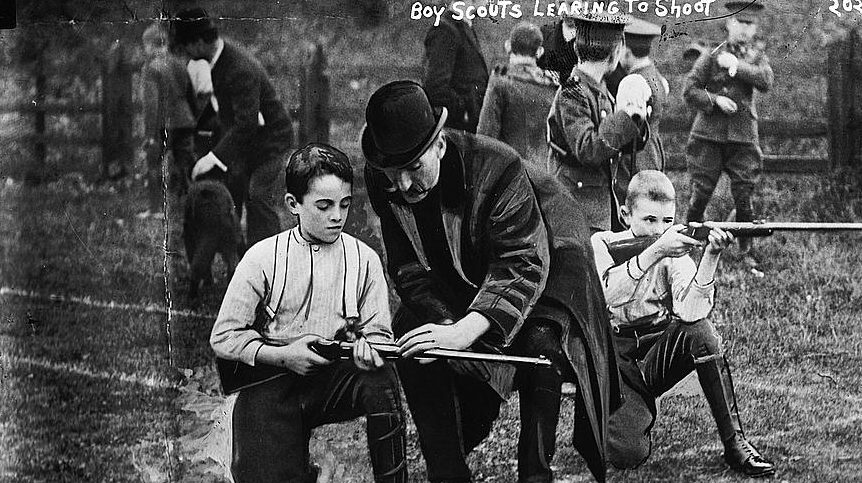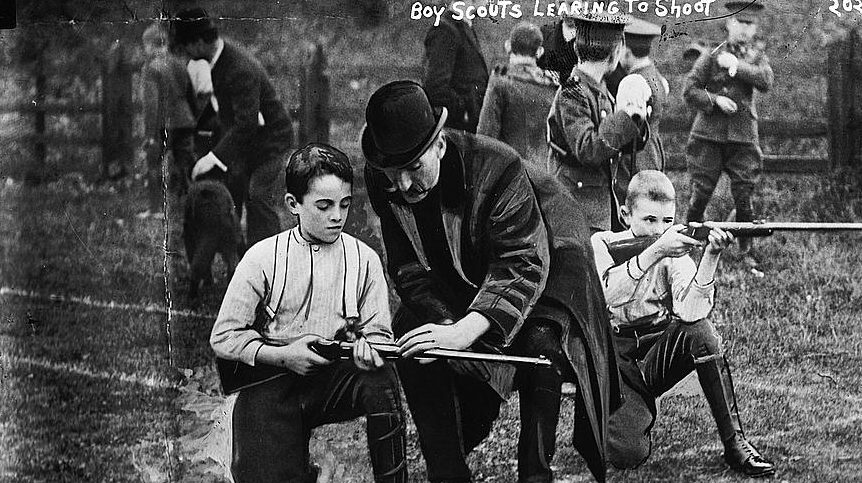An Old Boy Scout’s Journey – Part 2, by Rocket J. Squirrel


(Continued from Part 1.)
There is a DeWalt 6 kW generator with a Honda gasoline engine that was purchased used. The local Stihl dealer gave it a tune up. Spare spark plugs are kept in the tool box. I have very limited gasoline storage but do have a tri-fuel kit. The tri-fuel kit from www.uscarb.com enables the generator to use gasoline, propane, or natural gas for fuel. Make certain you buy the kit which matches your specific engine model. I need to get the kit installed as well as the natural gas fittings for our current home. Natural gas may have better availability than gasoline in a longer term grid down situation. This would be especially true for a localized power outage due to a short-term disaster such as a wind storm or hurricane. This is because most natural gas transmission pipelines now use gas turbine-driven compressors fueled by the natural gas in the pipeline rather than electric motor drivers.
It is unsafe and illegal in many jurisdictions to connect your portable generator to your house circuitry without a transfer switch. The transfer switch disconnects the wiring in your house from the utility distribution system. This is to avoid electrocuting/killing the power company linemen during a power outage. Yes, your little portable generator could do that. Without the transfer switch you will have long cords running to your refrigerator from the generator which needs to be located outside to avoid carbon monoxide poisoning of your family. I recently ran across an elegant, significantly lower cost solution compared to a traditional transfer switch set-up. Installing a GenerLink Meter Mounted Transfer Switch (includes a 20’ cord) is now on the to-do list. Home Depot has the lowest price ($650) I have found. I will have to get permission from the utility company to install it since the meter seal has to be broken for installation. Hire an electrician to do the installation. If you live in the Great White North, a generator with transfer switch will enable you to run the fan on your furnace during a power outage if you do not have a wood stove for heat. You obviously still need natural gas or propane to run your furnace in addition to the power for the fan.
First Aid:
Get training on how to handle the big three that are truly life-threatening emergencies: breathing, bleeding and poisoning. Treatment of life-threatening shock is next on the list and comes along with any significant injury. Everything else might be considered medium term care or longer.
We have various first aid kits in the house and cars. A medium term aid kit was assembled with various supplies and over-the-counter remedies and is stored in the house. Here are the contents of the big kit: Grundig Mini World 100 short wave radios (purchased used) with reel antennae, NukAlert radiation monitor, several RADSticker individual dosimeters, 500 g of potassium iodide USP from Post Apple Scientific (and printed instructions to make enough KI solution to treat 250 adults for 2 weeks, see www.ki4u.com/plan_b.htm), packages of QuikClot, 6” Israeli bandages, SWAT-T tourniquets, generic povidone solution, butterfly closures, light sticks, aspirin, ibuprofen, acetaminophen (children’s liquid too), Neosporin, Bacitracin, Vaseline, Sudafed, antacids, Imodium AD, hemostats, EMT shears, hydrocortisone ointment, zinc oxide ointment, meclizine (anti-nausea), and 200 meters Glide floss (emergency suture material), minor surgery kit, and an emergency dental kit. What I have assembled is certainly not complete. See https://www.ddponline.org/medkit.htm for a more complete list of kit contents compiled by an MD. In the kit I have printed hard copies of various instructions for use of the contents.
Still on the to-do list is to assemble a rehydration bucket to treat burn victims or those with diarrhea. See http://www.oism.org/s32p1868.htm for instructions. I have the required components (Morton Lite salt, baking soda, sugar) but it will be handy to have them in a single bucket as described in the link. Several boxes of N95 masks are stored in the garage.
The big kit is on the checklist of things to take with us in the event of an evacuation. I just realized that I need to place my hard copy of Nuclear War Survival Skills by Cresson Kearny in the big kit. You can download a free PDF copy of Nuclear War Survival Skills at https://www.oism.org/nwss/ but I always like to have a hard copy of my important reference books.
We have a few military surplus Individual First Aid Kits (IFAK) with Combat Application Tourniquet, nasopharyngeal airway and 4” emergency dressing. I need to add a package of QuikClot to each. I served as an usher at a large Christian congregation in Southern California. As part of our security training, I attended active shooter response training which included the use of the Combat Application Tourniquet and nasopharyngeal airway. (Our pastor in charge of security was wise and our active shooter response also included the security team shooting back at any assailant.)
A bottle of 190 proof Everclear is stored for making tinctures. My beautiful bride is the herbalist and has stocks of herbs and such that I do not understand. We all have different skills and things in which we are interested; that is an advantage of having a team. We recently purchased a colloidal silver kit from www.chriscolloidal.com. You can make your own kit less expensively. Chris even tells you how to do so on his web site, but I just bought the kit.
We have hard copies of several medical references in our library:
- Where There is No Doctor
- Where There is No Dentist
- Red Cross First Aid Handbook
- Staying Healthy in Asia, Africa, and Latin America
- Medicine for Mountaineering
- Wilderness Medicine
- Special Operations Forces Medical Handbook
- Combat Medic Field Reference
- Emergency War Surgery
- Physician’s Desk Reference (an old copy)
Note: We keep the more compact books in the big kit duffle bag.
Fire Fighting:
Nip fires in the bud! When the responders are overloaded, you may be on your own, but quick action is imperative, no matter what. If the fire department can respond immediately, they are likely several minutes away at the very best. A fire can grow significantly in that time. Knock down any fire immediately with an extinguisher.
I volunteered to be part of the community emergency response team organized by my employer and was fortunate enough to attend several days of excellent training over several years provided by fire fighters/nurses. Hands-on training was provided on organization, communication, search and rescue, building entry, victim extraction techniques, first aid, triage and fire fighting.
There are multiple fire extinguishers throughout our house and in the vehicles. Get the big 3-A:40-B:C rated extinguishers for inside the house. A 75’ by ¾” diameter hose with a nozzle may help you knock down a fire. The rule-of-thumb taught to us by the firefighters was that if the fire is bigger than a desk then it is too big to fight with an extinguisher; and hence it is time to retreat. This was based on the scenario of a team of two going into a building after an earthquake armed with two fire extinguishers. One person leads and the other follows and provides backup. If you have never used a fire extinguisher, then get some hands-on training.
Self Defense:
I have never been in a fist fight. My temperament is to avoid conflict and avoid being in dangerous situations in the first place. I expect that I would do reasonably well in a fist fight, but I really do not know for certain. So, I need to get some training, likely Krav Maga.
After the 1992 Rodney King riots in Los Angeles, and also after starting to read preparedness literature, I realized that I needed some firearms to protect my family. I started with a Remington 870 shotgun. Since I lived in the Republik of Kalifornia, I chose not to get any hand guns since they require registration. I hated the thought of registering a firearm. I investigated what other arms I should get. I researched SurvivalBlog, Boston’s Gun Bible, Mel Tappan’s book Survival Guns and many Internet sources.
The following types of firearms were selected and purchased:
- Shotgun: Remington 870 12 gauge. I eventually fitted them with weapon lights and side saddles. One has a 26” barrel which is now held in reserve for hunting; the normally mounted barrel is 18” with rifle sights. I need to mark the sights with luminescent paint.
- Main battle rifles: M1 Garand (from the CMP) and a Springfield M1A.
- For closer range and lighter weight: Ruger Ranch Rifle (Mini-14) (The AR-15 platform has been added now that I have escaped Kalifornia. I took Mr. Rawles’ advice and stocked up on amazingly inexpensive sale deals from Palmetto State Armory.)
- For learning how to shoot: Ruger 10/22.
- All have slings. A few have optics.
- On the to-do list is the purchase of a scoped Mossberg MVP bolt-action rifle in .308. The MVP is designed to accept M1A magazines. This means interchangeability between my chosen platforms and fewer magazine types to stock. Use of the M1A 10-round magazines will be transferred to use with the bolt-action per Jeff Cooper’s Scout Rifle platform concept. If you were to choose the MVP chambered in .223, then it will accept AR-15 magazines.
I chose those specific models since they were not categorized by Kalifornia as “assault rifles.” (When you think about it, is there any other type of rifle?) The M1A had to be California compliant and have a muzzle brake instead of an inherently evil flash hider. I also chose those models since they are chambered in ammunition which matches standard military calibers. The M1 Garand is originally .30-06 but you can get them from the CMP already re-barreled in .308/7.62×51. (Make certain that the ammunition you purchase for your Garand is loaded specifically for the Garand so it cycles correctly.) I confirmed with Ruger that the Mini-14 is dual rated for .223 and 5.56×45. And .22LR is relatively inexpensive and ubiquitous.
(To be continued tomorrow, in Part 3.)
